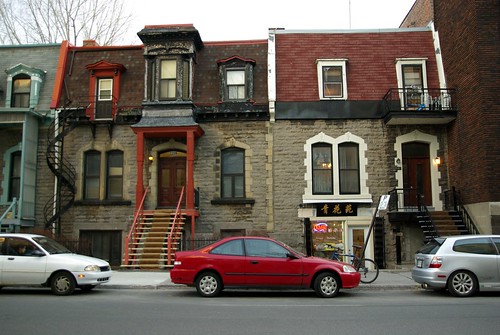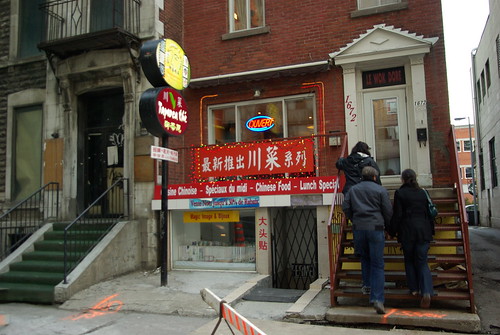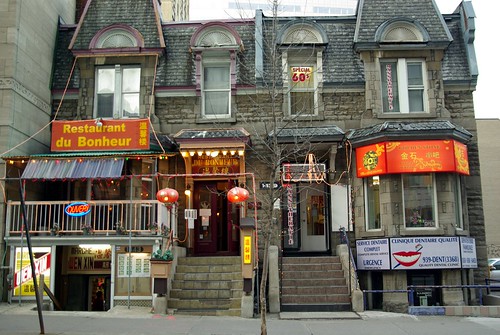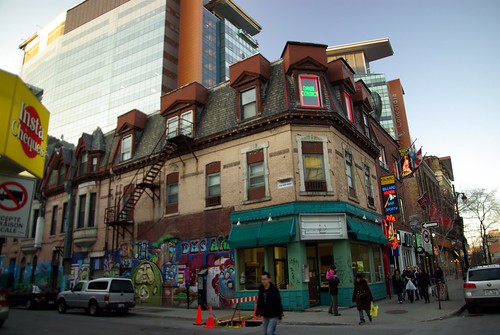I took advantage of Good Friday to go out with my camera to take pictures in the neighbourhood west of Concordia University. A new Chinatown has been thriving there for at least fifteen years. It was my personal experience as a consumer of Chinese food that usually led me to this area. It goes back to 1993 when Soupe et Nouilles’ (Ste-Cath & St-Marc) concept of a soup and noodles fast-food restaurant with its kitchen in front was still novel to many Montrealers.
What used to be confined to North Americanized versions of Cantonese and Szechuanese (Sichuanese) regional genres is now evolving along the growing student and immigrant population from Mainland China. We now see an influx of new quick food restaurants that you commonly find in China, like brochette (chuan – 串) and homemade noodles, dumplings houses.
The pork sandwich, two loaves of flat crunchy bread with a mix of braised fatty pork and coriander (see picture), can notably be found at a cafeteria-like resto on St-Mathieu north of the Metro exit. Homemade noodles and dumplings can also be found in the neighbourhood as a dumplings house opened on a residential stretch of St-Marc close to the Canadian Centre for Architecture.
General Tao Chicken and Orange Beef, ubiquitous in any Chinese restaurant ten years ago, are nowhere to be found in these of Chinatown West’s newest components.
Chinese restaurants, but also hair salons, “Asian-style” clothing stores now live side by side with Middle Eastern épiceries, takeouts and shisha joints. Whereas Chinatown is evolving in a very dramatic way with the building of a shiny new shopping and business centre, I find that Montreal’s other Chinatown has perhaps changed in a more gradual and low profile manner. And I’m sure it will continue to surprise me, at least food-wise.
View Montreal’s new Chinatown in a larger map
This article originally appeared on Comme les Chinois.






11 comments
On the map, you missed a small Chinese restaurant on MacKay between Ste-Catherine and de Maisonneuve, directly across the street from the Concordia library building. Also, I think there are a few Chinese restaurants in the Faubourg food court as well.
Apparently it has been spared OLF’S wrath… for now!
cool, actually the old-china town restaurants always let me down terribly and I will never try another one that labeled them “beijing food” in that neibourhood, they don’t even speak Mandarins let alone beijing tone! However, the places you mentioned are pretty nice, I like wei zhong wei(2nd pic) but the chuan restaurent near it is not up to my standard. A new Sichuan restaurent opened months before called Chuan Wei Xiuang, on Guy at the corner of Sherbrook, is attracting a lot of ppl, but it’s just too hot for me, hope you like it.
Tant mieux si ca peux retapper cette partie de Ste-Catherine qui dépérissait ! Il reste toujours le paté de maison sur Ste-Cat Ouest laissé à l’abandon par les Bronfman.
Adrien: L’OLF répond aux plaintes du public. Je doute qu’un commerce décidant d’afficher uniquement en chinois attire une grande clientèle non chinoise. En même temps, les 80% de Québécois francophones savent faire la différence entre un commerce ethnique et un commerce qui affiche uniquement en anglais par pure insouciance de la majorité francophone.
Interesting to see the changes since I left. I lived at 1236 St-Marc from 2001-3. The shop just to the north was, at that time, a dep that sold stale cigarettes and expired candy. I remember the owner asked me if I smoked pot, and tole me he preferred beer, because it’s cheaper.
Quoique je sympatise avec le fait que des immigrants tentent de gagner leur vie honnêtement, et que j’aime bcp la bouffe chinois authentique (d’autant plus des nouilles faites à la main), je ne peux m’empêcher de faire remarquer le double standard concernant la langue d’affichage…
==
I’ve often been asked about what my favourite Chinese restaurant in Montreal. While I’m not able to name one in particular (you go name your favourite molecule of oxygen!), the variety and novelty offered by those in Chinatown II never cease to amaze me.
In the meanwhile, I’m waiting patiently for that truly Shanghainese restaurant!
Même s’il y a beaucoup d’hyperbole aujourd’hui sur le rôle de la Chine dans nos affaires, la risque que Montréal devienne une ville sinophone demeure plutôt faible.
c’est l’anglais qui menace le français en amérique du nord, et c’est sur ça où l’Office de la langue française applique le plus d’effort. c’est aussi simple que ça!
Cédric,
Il y avait eu un grand débat dans les années 80 sur le double standard de la loi 101 sur l’Anglais et les autres langues (Et des hauts cris de discrimination, etc). Il suffit de voir les belles photos de Guillaume St-Jean pour réaliser à quel point Montréal s’anglicisait sous la pression des commercants et du monde des affaires jusque dans les années 60.
Le concensus fut que seul l’anglais menace le fait francais au Québec et que si les entreprises se mettent à fonctionner en anglais ou que les commerces n’affichent qu’en anglais, ca pourrait mener à un point de non-retour. De la l’imposition de la prédominance du francais sur les autres langues (mais l’interdiction de l’affichage de l’anglais est un mythe). L’imposition de l’école française aux immigrants est aussi une belle réussite car 90% des immigrants optaient pour l’école anglaise.
Par contre, le ”raison sociale” des commerces et entreprises peut etre unilingue dans une autre langue: Example: Children’s store ou Payless ou n’importe quel restaurant chinois. C’est ce que je vois sur tes photos. Mais si ils affichent leur menus dehors uniquement en chinois ou en anglais, ca serait à l’encontre de la lois. (Et une insulte pour les 80% de Québécois francophones).
P.S. Félicitation pour ton blogue
Thanks for this! I’ll definitely check them out sooner or later.
Interestingly, I have always found that Kam Shing restaurant in cote des neiges has the best chinese food in all of Montreal. Nowhere near Chinatown, always a lineup to get in, and always Chinese ppl eating there. You should check it out!
I wish my French was up to getting the nuances on the French entries about the language law and the unequal application of the law to anglophone and allophone signs.
‘newurbanshapes’ comment, from my poor French reading, seems to say since it is English which threatens the French language, the Office puts more resources against it. Not sure if he agrees what is sensible, but against the Charter of Rights and Freedoms, is defensible.
“c’est l’anglais qui menace le français en amérique du nord, et c’est sur ça où l’Office de la langue française applique le plus d’effort. c’est aussi simple que ça!”
I am of two minds: it offends my cheap anglo-cosmopolitanism, but I can also see the threat of a majority culture to a minority culture. I think it may have once been a regrettable necessity, but Quebecois culture is strong enough, and should now be proud enough, to repeal the law.
Quebec has given so much to this country, not least a political counterbalance to the right wing in Alberta, it is a shame that the legacy of a law which scared Anglos and Jews out of Montreal still stands. I have many Jewish friends whose families are from Montreal. No wonder they should have left, even if the nationalism was rarely directed against them. Staying too long is a mistake you don’t want to make twice in the 20th century.